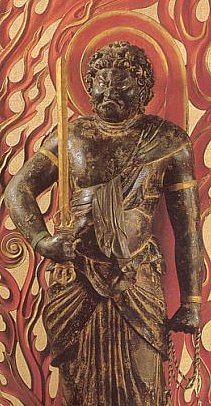Fudô Myôô
Description Of Form
Acala Vidyârâja (不動明王)in japanese is one of the Vidyârâjas (Myôôs) class of deities, and a very wrathful deity. He is one of the five 'wise kings' (明王- Myōō) of the womb realm. He is portrayed holding a sword in his right hand and a coiled rope in his left hand. With this sword of wisdom, Acala cuts through deluded and ignorant minds and with the rope he binds those who are ruled by their violent passions and emotions. He leads them onto the correct path of self control. Acala is also portrayed surrounded by flames, flames which consume the evil and the defilements of this world. He sits on a flat rock which symbolizes the unshakeable peace and bliss which he bestows to the minds and the bodies of his devotees.
Purpose and Vows
Acala transmits the teachings and the injunctions of Mahâvairocana to all living beings and whether they agree to accept or to reject these injunctions is up to them, Acala's blue/black body and fierce face symbolize the force of his will to draw all beings to follow the teachings of the Buddha. Nevertheless, Acala's nature is essentially one of compassion and he has vowed to be of service to all beings for eternity.
Acala also represents his aspect of service by having his hair knotted in the style of a servant: his hair is tied into seven knots and falls down from his head on the left side. Acala has two teeth protruding from out of his mouth, an upper tooth and a lower tooth. The upper tooth is pointed downward and this represents his bestowing unlimited compassion who are suffering in body and spirit. His lower tooth is pointed upward and this represents the strength of his desire to progress upward in his service for the Truth. In his upward search for Bodhi and in his downward concern for suffering beings, he represents the beginning of the religious quest, the awakening of the Bodhicitta and the beginning of his compassionate concern for others. It is for this reason that the figure of Acala is placed first among the thirteen deities.
His vow is to do battle with evil with a powerful mind of compassion and to work for the protection of true happiness. To pray for recovery from illness and for safety while traveling is to rely upon his vow and power to save. Acala is also the guide for the deceased, to help save them and assist them in becoming buddhas for the first seven days after death.
He is frequently described as a messenger, but his main function in the Mahāvairocana Abhisaṃbodhi Tantra is as a destroyer of obstacles.
In the MAT he is described thus:
"He holds a sword and a noose,
his plaited hair hangs from the left of his head,
he is well adorned and one of his eyes squints.
He abides amidst his own light*,
wrathfull seated upon a rock.
His face is creased in anger,
and he has a robust youthful form."
- (MAT II.40. Hodge : 113)
- The Chinese version of the text has "His awe-inspiring and wrathful body emanates flames" (Linrothe : 152) which is more consistent with images. The flames in his aura are the flames which transmute mundane anger into the Mirror-like Wisdom.
Acala means "immovable". Vidya can mean knowledge, but is also a synonym for mantra and is frequently used to refer to magic. It can be taken to mean something like esoteric knowledge. Rāja means "king". He is also known simply as Acala (Fudō), or as Acalanātha, "immoveable lord". Fudō is also part of a group of Vidyārājas. .
Fudō's seed syallble is hāṃ, or sometimes hammaṃ, which is a combination of the two final bīja's from his mantra.
The mantra comes from the Mahāvairocana Abhisaṃbodhi Tantra. It occurs for instance in chp. 4, the General Mantra Treasury (Hodge : 161). Acala is one of only three wrathful figures in the MAT along with Trailokyavijaya and Hayagrīva.
In the Siddhaṃ I have used the practice of indicating nasals in caṇḍa for instance by using the anusvāra on the prceeding vowel. The fact that the following consonant is ḍ tells us that the nasal must be of the same articulation, ie ṇ. In the Tibetan and Devanāgarī I have used conjunct consonants.
This is a wrathful mantra which includes words which must be understood in the context of Tantric Buddhism. For instance caṇḍa means "violent", mahāroṣaṇa means "great wrath", and sphoṭaya means "destroy". Anger is associated with, and transformed through Tantric practices into the Mirror like Wisdom of Akṣobhya that sees perfectly clearly. The energy of the anger is directed towards breaking through to Buddhahood, it breaks through spiritual ignorance. There is no sense in which this justifies expressing mundane anger towards people as the anger of the Bodhisattva arises out of Compassion for their suffering, and is rooted in Perfect Wisdom. The Mahāvairocana Abhisaṃbodhi Tantra insists that the mantra is to be recited while keeping Bodhicitta in mind:
" Recollecting bodhicitta, the matrin
Should mentally recite the Acala mantra,
And make his Mudrā,
And he will destroy all obstacles." (MAT III.4. Hodge : 154)
As well as destroying obstacles, the Acala mantra can be used for occupying the ground where a mandala is being created. Tantric texts seem to assume that creating a mandala is something that one does on an actual plot of land, although this could of course be symbollic.
In later tantric texts Chaṇḍa Mahāroṣaṇa becomes a distinct figure.
Mantra
Nômaku sanmanda bazaradan senda makaroshada sowataya un tarata kanman. (Jpn.)
Namah samanta-vajrânâm canda mahârosana sphotaya hûm trat hâm mâm (Skt.)
Homage to the all-pervading Vajras! O Violent One of great wrath! Destroy! hûm trat hâm mâm
